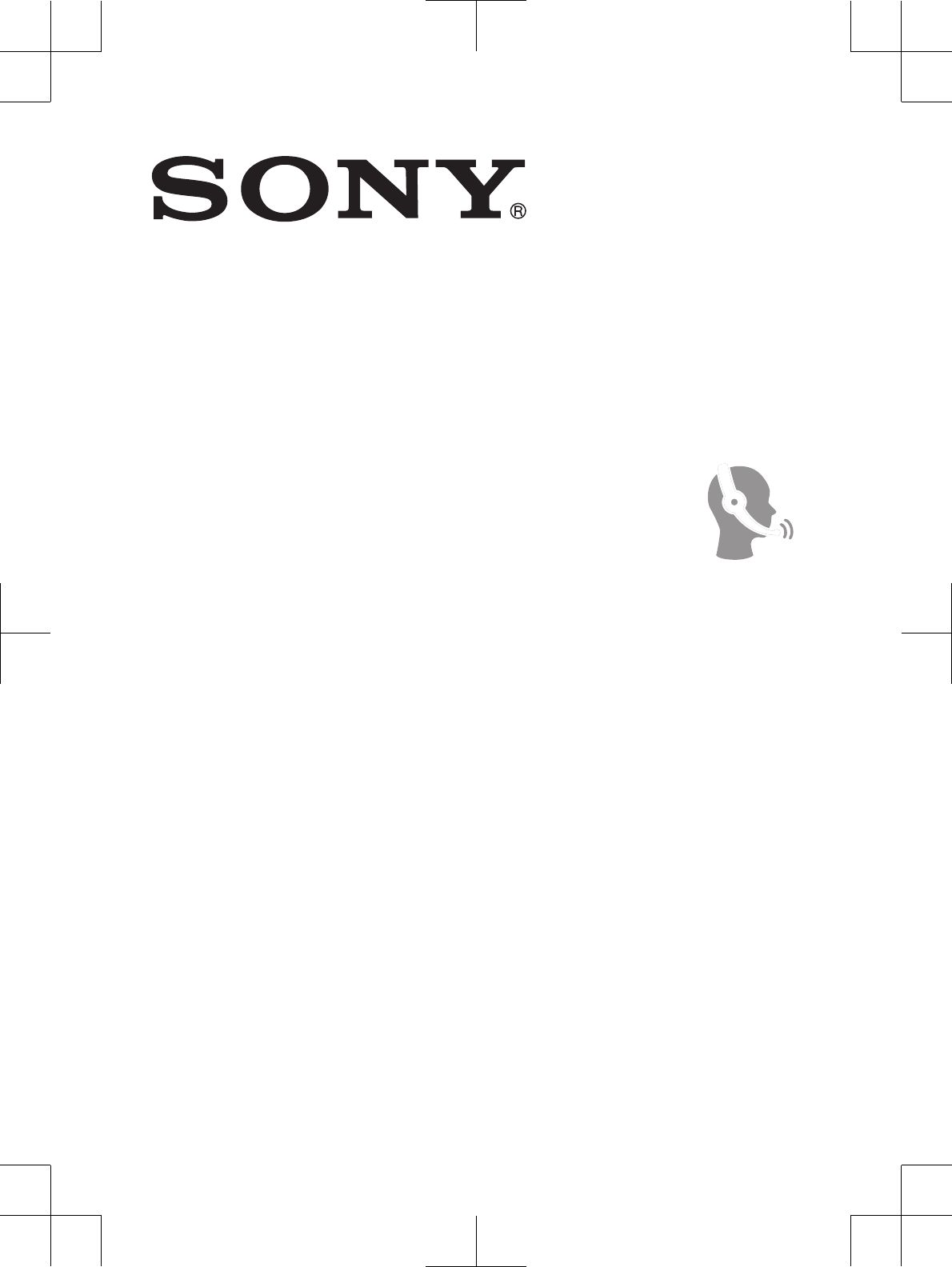Sony PM-0740 GSM/UMTS/LTE Mobile Phone with WLAN, BT, RFID, ANT+ User Manual Sirius Gina SAR FCC IC leaflet 01222014R
Sony Mobile Communications Inc GSM/UMTS/LTE Mobile Phone with WLAN, BT, RFID, ANT+ Sirius Gina SAR FCC IC leaflet 01222014R
Sony >
Contents
Safety Leaflet

SAR Information
FCC Statement
Declaration of Conformity
Sony '5503
UMTS HSPA Band 1 2 4 5 8 GSM GPRS/EDGE
850/900/1800/1900 LTE Band 1 2 3 4 5 7 8 20
D6503
1 2 3 4 5 7 8 13 17 20

Important Information
United States & Canada
THIS PHONE MODEL HAS BEEN CERTIFIED IN COMPLIANCE
WITH THE GOVERNMENT’S REQUIREMENTS FOR EXPOSURE
TO RADIO WAVES.
The '5503 Series mobile phones have been designed to
comply with applicable safety requirements for exposure to
radio waves. Your wireless phone is a radio transmitter and
receiver. It is designed to not exceed the limits* of exposure to
radio frequency (RF) energy set by governmental authorities.
These limits establish permitted levels of RF energy for the
general population. The guidelines are based on standards
that were developed by international scientific organizations
through periodic and thorough evaluation of scientific studies.
The standards include a safety margin designed to assure the
safety of all individuals, regardless of age and health.
The radio wave exposure guidelines employ a unit of
measurement known as the Specific Absorption Rate (SAR).
Tests for SAR are conducted using standardized methods with
the phone transmitting at its highest certified power level in all
used frequency bands. While there may be differences
between the SAR levels of various phone models, they are all
designed to meet the relevant guidelines for exposure to radio
waves. For more information on SAR, please refer to the
Important Information chapter in the User Guide.
The highest SAR value as reported to the authorities for this
phone model when tested for use by the ear is . W/kg*,
and when worn on the body is . W/kg*. For body-worn
operation, the phone has been tested when positioned a
minimum of 15 mm from the body without any metal parts in
the vicinity of the phone or when properly used with an
appropriate accessory and worn on the body. For devices
which include “WiFi hotspot” functionality, SAR measurements
for the device operating in WiFi hotspot mode were taken
using a separation distance of 10 mm. Use of third-party
2
1.34 W/kg*
0.82 W/kg*.

accessories may result in different SAR levels than those
reported.
**Before a phone model is available for sale to the public in
the US, it must be tested and certified by the Federal
Communications Commission (FCC) that it does not exceed
the limit established by the government-adopted requirement
for safe exposure*. The tests are performed in positions and
locations (i.e., by the ear and worn on the body) as required by
the FCC for each model. The FCC has granted an Equipment
Authorization for this phone model with all reported SAR levels
evaluated as in compliance with the FCC RF exposure
guidelines. While there may be differences between the SAR
levels of various phones, all mobile phones granted an FCC
equipment authorization meet the government requirement for
safe exposure. SAR information on this phone model is on file
at the FCC and can be found under the Display Grant section
of http://transition.fcc.gov/oet/ea/fccid after searching on FCC
ID PY7PM-0640. Additional information on SAR can be found
on the Mobile Manufacturers Forum EMF website at
http://www.emfexplained.info/.
* In the United States and Canada, the SAR limit for mobile
phones used by the public is 1.6 watts/kilogram (W/kg)
averaged over one gram of tissue. The standard incorporates a
margin of safety to give additional protection for the public and
to account for any variations in measurements.
**This paragraph is only applicable to authorities and
customers in the United States.
3
ID: PY7PM-0740.

Renseignements importants
États-Unis et Canada
CE MODÈLE DE TÉLÉPHONE A ÉTÉ CERTIFIÉ CONFORME AUX
EXIGENCES GOUVERNEMENTALES RELATIVES À
L'EXPOSITION AUX ONDES RADIOÉLECTRIQUES.
Les téléphones mobiles de la '5503 ont été conçus pour
répondre aux normes de sécurité en vigueur en matière
d'exposition aux ondes radioélectriques. Votre téléphone sans fil
est un émetteur et un récepteur radio. Il est conçu de manière à
ne pas dépasser les limites* d'exposition à l'énergie des
fréquences radio (RF) établies par les autorités
gouvernementales. Ces limites fixent les niveaux maximaux
d'énergie RF auxquels peut être soumis le grand public. Ces
lignes directrices sont basées sur des normes qui ont été
élaborées par des organisations scientifiques internationales par
le biais d'évaluations périodiques et approfondies des études
scientifiques. Ces normes prévoient une marge de sécurité visant
à assurer la protection de tous les individus, peu importe leur
âge et leur état de santé.
Les lignes directrices relatives à l'exposition aux ondes
radioélectriques utilisent une unité de mesure appelée « Taux
d'absorption spécifique » (TAS). Les tests de TAS sont effectués
selon des méthodes standardisées dans lesquelles le téléphone
émet dans toutes les bandes de fréquences utilisées, à la plus
forte puissance pour laquelle il a été homologué. Bien que le
TAS puisse être différent d'un modèle de téléphone à un autre,
tous les appareils sont conçus pour respecter les lignes
directrices relatives aux ondes radioélectriques. Pour en savoir
plus sur le DAS, reportez-vous au chapitre sur les
renseignements importants du guide de l'utilisateur.
Le DAS le plus élevé relevé par les autorités pour ce modèle
de téléphone est de . W/kg* lorsqu'il est testé en utilisation
près de l'oreille, et de . W/kg* lorsqu'il est porté sur le
corps. En mode d’utilisation porté sur le corps, le téléphone a
été testé lorsqu’il est à au moins 15 mm du corps et à l’écart de
toute pièce en métal, ou lorsqu’il est utilisé de façon adéquate
4
1.34 W/kg*
0.82 W/kg*

avec un accessoire et porté sur le corps. Pour les appareils
munis de la fonctionnalité « point d'accès WiFi », les mesures du
DAS de l'appareil en mode WiFi ont été prises à une distance de
sécurité de 10 mm. L'utilisation d'accessoires tiers peut produire
des niveaux de DAS différents de ceux relevés.
**Avant qu'un modèle de téléphone ne soit mis en vente
auprès du public aux États-Unis, la Commission fédérale des
communications (CFC) doit le tester et certifier qu'il respecte les
limites fixées dans les exigences gouvernementales d'exposition
sans danger*. Pour chaque modèle, les tests sont effectués en
position et aux endroits d'usage (c.-à-d. près de l'oreille et porté
sur le corps), tel que requis par la CFC. La CFC a accordé une
autorisation d'équipement pour ce modèle de téléphone, après
que tous les niveaux de TAS indiqués aient été évalués et
considérés conformes aux lignes directrices de la CFC en
matière d'exposition aux radiofréquences. Même s'il peut y avoir
des différences entre les niveaux de TAS des différents
téléphones, tous les téléphones mobiles auxquels la CFC a
accordé une autorisation d'équipement répondent aux normes
gouvernementales en matière d'exposition sans danger. La CFC
conserve dans ses dossiers l'information relative aux TAS relevés
pour ce modèle de téléphone. Vous pouvez la consulter au
http://transition.fcc.gov/oet/ea/fccid sous la rubrique « Display
Grant », après avoir effectué une recherche sur CFC
ID PY7PM-0640. Vous trouverez des renseignements
supplémentaires concernant le DAS sur le site Web du Mobile
Manufacturers Forum MMF au http://www.emfexplained.info/.
* Aux États-Unis et au Canada, la limite de TAS des
téléphones mobiles utilisés par le public est de 1,6 watt/kg
(W/kg) en moyenne sur un gramme de tissus. Cette norme
comporte une marge importante de sécurité afin d'assurer une
protection supplémentaire et de tenir compte de toute variation
dans les mesures.
**Ce paragraphe ne concerne que les autorités et les clients
des États-Unis.
5
ID PY7PM-0740.

FCC Statement
This device complies with Part 15 of the FCC rules.
Operation is subject to the following two conditions:
(1) This device may not cause harmful interference,
and (2) This device must accept any interference received,
including interference that may cause undesired operation.
Any change or modification not expressly approved by Sony
may void the user's authority to operate the equipment.
This equipment has been tested and found to comply with
the limits for a Class B digital device, pursuant to Part 15 of
the FCC Rules. These limits are designed to provide
reasonable protection against harmful interference in a
residential installation. This equipment generates, uses and
can radiate radio frequency energy and, if not installed and
used in accordance with the instructions, may cause harmful
interference to radio communications. However, there is no
guarantee that interference will not occur in a particular
installation.
If this equipment does cause harmful interference to radio or
television reception, which can be determined by turning the
equipment off and on, the user is encouraged to try to correct
the interference by one or more of the following measures:
•Reorient or relocate the receiving antenna.
•Increase the separation between the equipment and
receiver.
•Connect the equipment into an outlet on a circuit different
from that to which the receiver is connected.
•Consult the dealer or an experienced radio/TV technician for
help.
17
Caution:
Your device can only connect to an FCC approved access point when
using 5 GHz WLAN for indoor and outdoor operation. This is because
operation in the 5.15 GHz to 5.25 GHz frequency band is only
permitted for indoor use.

Industry Canada Statement
This device complies with RSS-210 of Industry Canada.
Operation is subject to the following two conditions: (1) this
device may not cause interference, and (2) this device must
accept any interference, including interference that may cause
undesired operation of the device.
This Class B digital apparatus complies with Canadian
ICES-003.
Cet appareil numérique de la classe B est conforme à la
norme NMB-003 du Canada.
Operation in the band 5150-5250 MHz is only for indoor use
to reduce the potential for harmful interference to co-channel
mobile satellite systems. Please note that high-power radars
are allocated as primary users (i.e. priority users) of the bands
5250-5350 MHz and 5650-5850 MHz and that these radars
could cause interference and/or damage to LE-LAN devices.
Avis d’industrie Canada
Le présent appareil est conforme aux CNR d'Industrie Canada
applicables aux appareils radio exempts de licence.
L'exploitation est autorisée aux deux conditions suivantes:
(1) l'appareil ne doit pas produire de brouillage, et, and (2)
l'utilisateur de l'appareil doit accepter tout brouillage
radioélectrique subi, même si le brouillage est susceptible
d'en compromettre le fonctionnement.
18